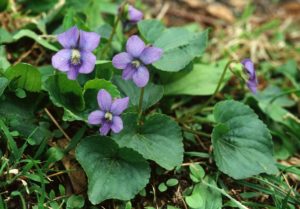| Common Name(s) | Common Blue Violet | ||||
| Scientific Name | Viola sororia | ||||
| Family | Violaceae | ||||
| Location/Vegetative Zone | Woods, thickets, and stream banks | ||||
| Flowering Period | April-August | ||||
| Identifying Characteristics | 3-8” tall, wide heart-shaped leaves, and large blue-violet flowers (sometimes white with purple veins) | ||||
Description
- Perennial plant
- Grows 3-8” tall
- Leaves are:
- Downy, basal, heart-shaped
- Wide (3” long, 3” wide)
- Yellowish green to dark green depending on growing conditions
- Can be crenated or serrated along the edge
- Has blue-violet flowers
- 5 petals
- Medium to dark violet
- Inner throat of flower may be white
- Dark purple veins radiate outward
- Blooms from April-August for about 1½ months
- After blooming, the plant produces seed pods with many dark brown seeds inside; the seeds are ejected out of the pod
Misc
- Habitat:
- black soil prairies, open woodlands, woodland edges, savannas, and wooded slopes along rivers or lakes
- likes rich silty loam or clay loam with above average amounts of organic matter
- common to North America; grows from Wisconsin to the East Coast and north to Canada
- likes partial sun or light shade, and moist to average conditions, although full sun is tolerated if there is sufficient moisture
- Spreads easily; can be found in lawns, city parks, moist waste areas, and along hedges or buildings
- The flowers and leaves are edible, and some say that the roots are edible as well.
- The Cherokee Indians used it to treat colds and headaches. Has also been used to treat coughs, sore throats, and constipation.
- State flower of Illinois, Rhode Island, Wisconsin and New Jersey
3,025 total views, 1 views today

